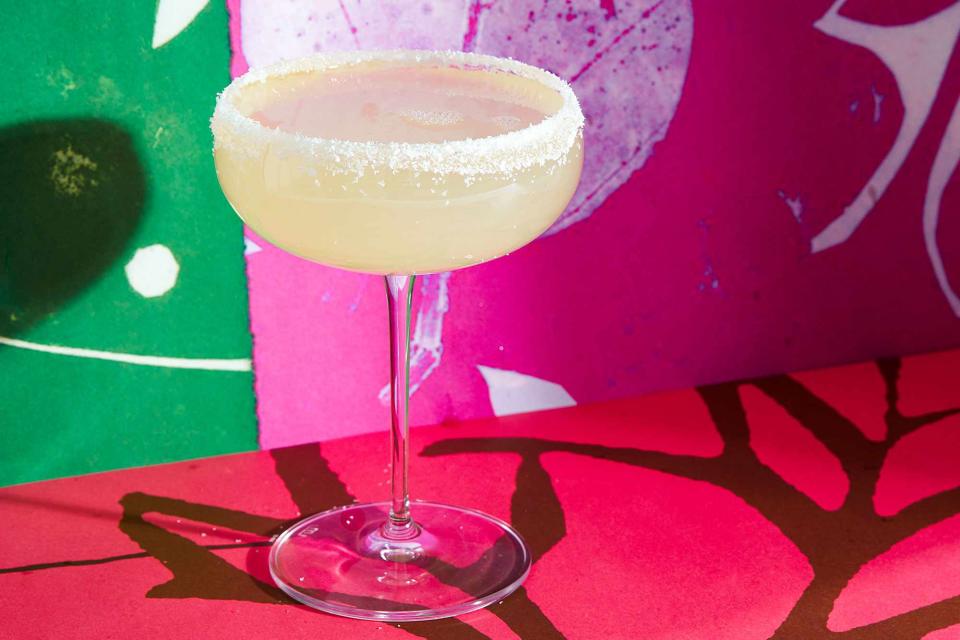Is the Margarita the World's Most Dangerous Cocktail?
Here's what you really need to know before you make Margaritas in the sun.

Matt Taylor-Gross / Food Styling by Oset Babur-Winter
Last summer, I was making a big batch of Margaritas in my backyard by squeezing all of the limes with a handheld juicer — technically called a reamer — like this one. My wrist ached in the moment, but by the next day, the pain was in my entire hand. I was typing away at my computer, and I noticed my right hand (and only my right hand) was fire-engine red. While I am regrettably the type of fair-skinned person who is almost always red, I could tell this was no sunburn.
Even still, it was strange. I had globbed on way too much SPF 100 (my dad is a dermatologist) the day before, and no other part of my body was bright red. It was just my one hand.
I texted my dad a picture and he responded almost instantly: “Did you drink Margaritas yesterday?”
Related: Make a Better Margarita With These 5 Tequilas
Back off Dad, I thought, I’m an adult, I can do what I want. I think I texted him back just the letter “y,” proving that I might not be an adult after all. But the answer was indeed, yes. I had made a big batch of Margaritas, and they were delicious, thanks for asking.
My dad wasn’t after my recipe, though. “It’s Margarita burn,” he wrote, adding, “You’re fine,” before not responding to any of my further questions, like “Will my hand need to be amputated?” or “Can you die from it?” I even tried baiting him with “Where do you want to go to dinner next week?” and still, nothing.
So, I turned to the internet, which gave me two answers: The first was a reminder to never Google a skin condition and click on the images tab ever again. The second was useful information I was actually seeking.
It turns out the medical term for this condition (more colloquially known as Margarita burn) is phytophotodermatitis, a word that, in my opinion, seems like it was specifically invented to be difficult to pronounce after drinking a Margarita.
Related: 3 Extremely Extra Margaritas to Try at Home
But despite its mouthful of a name, it’s a fairly common condition — it’s truly all over my TikTok feed, and it can get a lot worse than just redness. In fact, according to New York-based board certified dermatologist, Dr. Whitney Bowe, extensive exposure to the plant based chemicals in citrus could be very serious, and even potentially (but very unlikely) fatal.
According to Bowe, the most common cases of Margarita burn stem from lime juice — hence the nickname — but the condition can actually occur when your skin comes in contact with foods like celery (so watch out if you love Bloody Marys) or parsley. The key unifier between these ingredients? Bowe says they’re all phototoxic, meaning if and when they come in contact with your skin as well as the sun, you can find yourself dealing with severe burns, blistering, and hyperpigmentation. And while the effects may just look like a sunburn, these symptoms can last for months.
It’s probably a reaction you’re well acquainted with. Remember the old trick of using lemon juice to keep your hair blonde? Same thing here, except the end result is not quite as stylish.
In fact, Bowe recalls one patient who woke up one day with a dark streak down her arm, and kept trying to wash off. “It was hyperpigmentation arising from phytophotodermatitis, and it had skipped the sunburn and blister stage and just went straight to what looked like a stain on her skin,” she says.
Related: Our Best Margarita Recipes
“I wonder if this is an interesting angle for canned cocktail companies to take,” wonders Erin Ashford, bar director at Holiday on 7th, an Austin, Texas bar famous for its frozen Mexican Martini. Completely forgoing freshly made drinks is not a route Ashford, a self-described Margarita-lover is willing to take. “I’ll just keep slathering on sunscreen and wearing a big hat,” she jokes.
Bowe says you don’t have to give up the fresh ingredients and recommends cleaning your hands with soap and water thoroughly after squeezing citrus, then applying more sunscreen. She even adds that you can wear gloves while you are handling these foods prior to going out into the sun.
For me? Well, I’m going to follow all of this advice. And one more thing: I’m getting an electric juicer.
For more Food & Wine news, make sure to sign up for our newsletter!
Read the original article on Food & Wine.

